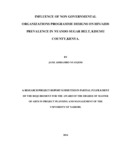| dc.description.abstract | HIV prevalence among adults aged between 15-64 years has decreased nationally from 7.2% to
5.6% in the year 2012 according to the Kenya Aids Indicator Survey, while among the children
aged 18 months to 14 years it was 0.9%.Prevalence among adults varied by regions with the
highest being Nyanza region where we have two sugar belts and the lowest being the North
Eastern region. Most regions have also showed substantial decrease in prevalence with the
notable ones being Coast at 4.3% from 8.1%, Nairobi at 4.9% from 8.8% and Rift valley at 3.7%
from 6.3%. Prevalence rates are a reflection of both new infections within a group and deaths of
those infected. Since time immemorial different programmes have been put into place by
different NGOs. There are several interventions that have been dealing with the issue of
HIV/AIDS in this country and specifically in Nyando Sugar Belt, however, much more needs to
be done as there is still a gap especially on the designs of these HIV/AIDS related programmes.
The purpose of this study was to investigate how the NGOs programme design influences
HIV/AIDS prevalence in Nyando sugar belt. Sugar belts being regions where the HIV prevalence
is normally high due to the disposable income and the migration of the employees from one
sugar factory to another. The objectives of the study were to establish the level at which
stakeholder related designs influenced HIV/AIDS prevalence,, to assess the extent to which
NGOs management oriented designs influenced HIV/AIDS prevalence, to investigate
sustainability related designs of NGOs and its influence on HIV/AIDS prevalence and to also
determine how the application and intensity of activity design influences HIV/AIDS prevalence
in Nyando Sugar Belt. This study used the Descriptive Survey and correlational research designs.
The target population consisted of CEO’s of the NGOs and the community beneficiaries. The
sample size was 331. The study used the simple random sampling technique to get the sample
from the beneficiaries and purposive sampling for the CEO’s of the non-governmental
organizations Data collection was through questionnaires for the beneficiaries and data from the
CEO’s was collected with the help of an interview schedule. On validity and reliability of the
instruments, pilot testing was carried out to ensure this. The data collected from the field was
analyzed and interpreted using the Statistical Programme for Social Sciences. Standard multiple
regression, correlation and Pearson chi square test of independence methods of data analysis
were employed. The study concluded that some programme designs did not match the people’s
needs and that management oriented designs were not fully functional except for competent staff.
The findings show that stakeholder oriented designs had a generally low influence on HIV/AIDS
prevalence in the region with a variation of 5.7%. They also revealed that there were no
measures to ensure sustainability of the projects except an initiative for circumcision and that
activities were not evenly distributed in the region. The study recommended continuous
involvement of community members in the programmes and activities and proper campaigns to
create awareness among the residents so as to seek various services. It is hoped that the findings
of this effective study may help donors, programme staff of various prevention interventions in
NGOs and all stakeholders to adapt, modify and come up with comprehensive programmes in
future. | en_US |

